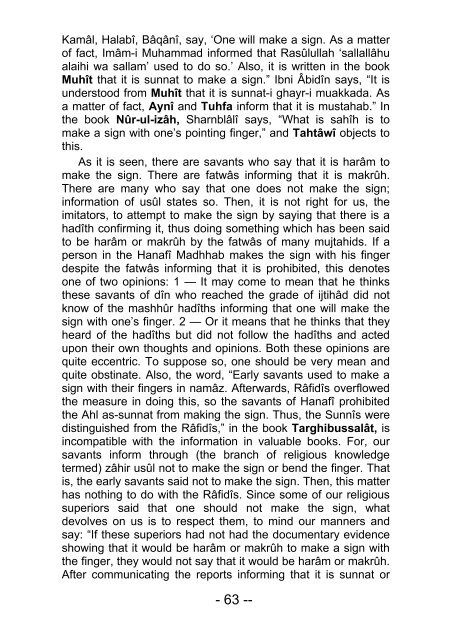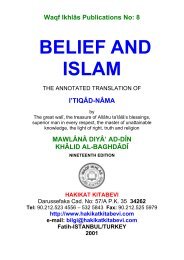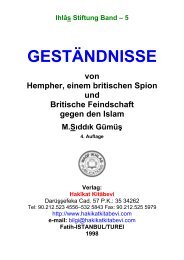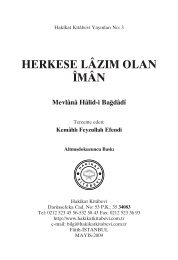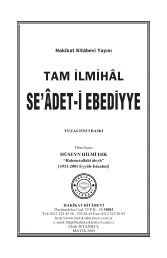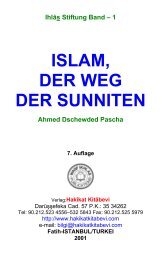3-Endless Bliss Third Fascicle - Hakikat Kitabevi
3-Endless Bliss Third Fascicle - Hakikat Kitabevi
3-Endless Bliss Third Fascicle - Hakikat Kitabevi
Create successful ePaper yourself
Turn your PDF publications into a flip-book with our unique Google optimized e-Paper software.
Kamâl, Halabî, Bâqânî, say, ‘One will make a sign. As a matter<br />
of fact, Imâm-i Muhammad informed that Rasûlullah ‘sallallâhu<br />
alaihi wa sallam’ used to do so.’ Also, it is written in the book<br />
Muhît that it is sunnat to make a sign.” Ibni Âbidîn says, “It is<br />
understood from Muhît that it is sunnat-i ghayr-i muakkada. As<br />
a matter of fact, Aynî and Tuhfa inform that it is mustahab.” In<br />
the book Nûr-ul-izâh, Sharnblâlî says, “What is sahîh is to<br />
make a sign with one’s pointing finger,” and Tahtâwî objects to<br />
this.<br />
As it is seen, there are savants who say that it is harâm to<br />
make the sign. There are fatwâs informing that it is makrûh.<br />
There are many who say that one does not make the sign;<br />
information of usûl states so. Then, it is not right for us, the<br />
imitators, to attempt to make the sign by saying that there is a<br />
hadîth confirming it, thus doing something which has been said<br />
to be harâm or makrûh by the fatwâs of many mujtahids. If a<br />
person in the Hanafî Madhhab makes the sign with his finger<br />
despite the fatwâs informing that it is prohibited, this denotes<br />
one of two opinions: 1 — It may come to mean that he thinks<br />
these savants of dîn who reached the grade of ijtihâd did not<br />
know of the mashhûr hadîths informing that one will make the<br />
sign with one’s finger. 2 — Or it means that he thinks that they<br />
heard of the hadîths but did not follow the hadîths and acted<br />
upon their own thoughts and opinions. Both these opinions are<br />
quite eccentric. To suppose so, one should be very mean and<br />
quite obstinate. Also, the word, “Early savants used to make a<br />
sign with their fingers in namâz. Afterwards, Râfidîs overflowed<br />
the measure in doing this, so the savants of Hanafî prohibited<br />
the Ahl as-sunnat from making the sign. Thus, the Sunnîs were<br />
distinguished from the Râfidîs,” in the book Targhibussalât, is<br />
incompatible with the information in valuable books. For, our<br />
savants inform through (the branch of religious knowledge<br />
termed) zâhir usûl not to make the sign or bend the finger. That<br />
is, the early savants said not to make the sign. Then, this matter<br />
has nothing to do with the Râfidîs. Since some of our religious<br />
superiors said that one should not make the sign, what<br />
devolves on us is to respect them, to mind our manners and<br />
say: “If these superiors had not had the documentary evidence<br />
showing that it would be harâm or makrûh to make a sign with<br />
the finger, they would not say that it would be harâm or makrûh.<br />
After communicating the reports informing that it is sunnat or<br />
- 63 --


